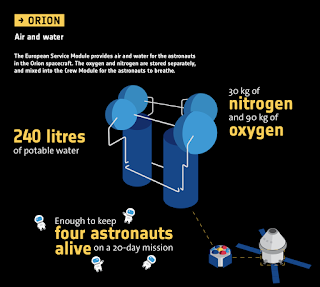 |
| Journée officielle de la réception du module de service Orion le 16 novembre 2018 au Centre des opérations du KSC. – Photo: rke |
[Cape Canaveral, November 27, 2018, rke (English, below] – Je reviens à vous, comme la grêle après les vendanges, comme on dit en Suisse. Et en France, je suppose. La NASA et l’agence spatiale européenne (ESA), nous ont dévoilé vendredi 16 novembre, dans le Centre des opérations du Kennedy Space Center (O&C High Bay Available SMEs), autrement dit le hangar des capsules Apollo réaménagé en salle de montage des bouts de fusées modernes, le module Orion. Beaucoup de beau monde pour cette inauguration officielle du Module de service (SM), tout le gratin des officiels. On n’a pas eu l’occasion d’interviewer ces gens-là à ce moment-là, mais lors de la conférence de presse qui s’est tenue ensuite au centre de presse du KSC.

 |
| Philippe Deloo. - Photo: rke |
 |
| Johann-Dietrich Wörner ESA Director general. – Photo : rke |
Orion, c’est le nouveau véhicule de la NASA pour explorer l’univers. D’abord la Lune, puis Mars, puis le reste. L’engin est compensé en deux parties : une habitable et l’autre consommable. C’est cette dernière qui a été inaugurée et je ne suis pas peu fier puisqu’elle provient un peu de Suisse. Ce module de service sert à… servir, ce qui veut dire que sans lui, rien ne peut plus fonctionner dans le véhicule habitable. C’est un peu comme si vous roulier sans moteur ni carburant, ni courant, ni chauffage, etc.
 |
| Mon badge.. parmi tant d'autres. |
Le SM sert donc, comme l’image l’indique ci-contre, à fournir la propulsion (hélium) du véhicule, de l’eau à l’équipage et du courant grâce aux panneaux solaires (19 m de long). Et c’est là que notre pays entre en jeu avec d’autres pays européens (voir carte). RUAG à Zurich s’est occupé du mécanisme de rotation de ces panneaux. « C’est l’une des pièces essentielles du module », m’ont confié sur place Philippe Deloo chef de projet et Philippe Berthe, chef du programme du module à l’ESA. Effectivement, cela correspond un peu à la fonction de la rotule de notre genou ou notre coude. Sans cette pièce, les panneaux solaires ne pourraient plus s’orienter correctement vers le soleil. Plus de courant, plus voyage. En outre, APCO technologies à Vevey s’est occupé de la manutention du module d’Orion (comme de nombreux autres satellites) : levage, manipulation, test, positionnement, transport, etc.

Le recours à un système européen pour assurer des capacités indispensables au fonctionnement d’un engin spatial américain constitue donc une première pour la NASA. Le partenariat noué dans le cadre de la Station spatiale internationale prend ainsi une nouvelle dimension, visant cette fois l’espace lointain.
 |
| Johann-Dietrich Wörner ESA Director general during the official day. – Photo: rke |
NASA/ESA – Orion. The ball joints of the solar panels are Swiss made
 |
| David Parker, Director of Human and Robotic Exploration (ESA) and Johann-Dietrich Wörner ESA Director general. – Photo : rke |
[Cape Canaveral, November 27, 2018, rke] – I come back to you, like hail after the harvest, as they say in Switzerland. And in France, I suppose. NASA and the European Space Agency (ESA), unveiled Friday, November 16, 2018, in the Kennedy Space Operations Center (O & C High Bay Available SMEs), in other words, the Apollo hangar capsules refitted in assembly room of the ends of modern rockets, the Orion module. Many high personalities for this official inauguration of the Service Module (SM) were present. We did not have the opportunity to interview some leaders at that time, but later to the press conference held at the KSC Press Center.
 |
| Johann-Dietrich Wörner ESA Director general. – Photo : rke |
The SM thus serves, as the image indicates it opposite, to provide the propulsion (helium) of the vehicle, of the water to the crew and the current thanks to the solar panels (62,3 feet).
And Switzerland, precisely contributed to the realization of this module… with other European countries (see map). RUAG in Zurich (Center) has developed the rotation mechanism of these panels. "This is one of the essential parts of the module," Philippe Deloo, project manager and Philippe Berthe, module program manager at ESA, told me on site. Indeed, it corresponds a little to the function of the patella of our knee or our elbow. Without this element, solar panels can no longer orient themselves properly towards the sun. Without power, no movement.
The completion of the service module in Europe signifies a major milestone in the journey toward human exploration missions to the Moon, Mars and beyond.












